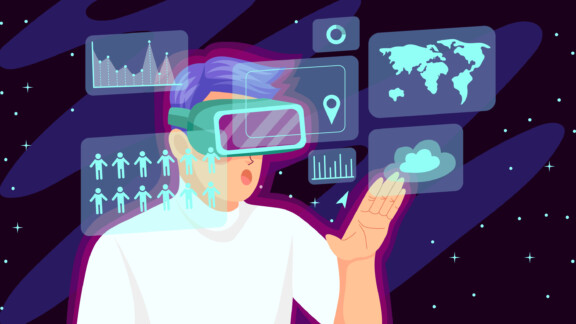
What is the metaverse?
A broad definition of the metaverse would be “a future version of the Internet where virtual spaces, persistent and shared, are accessible via 3D interaction”. The meaning of the metaverse that comes instinctively to mind is one of virtual spaces with avatars, often video games, accessible through virtual reality helmets. This form of the metaverse is the most immersive, the one that requires the most equipment, technological knowledge, and therefore, the one least used at the moment. The metaverse is already present in the daily lives of many cybernauts, in less immersive forms. Think of augmented reality, often used in our cell phones, where images are superimposed on real background decor or on a face (for example, certains filtres sur Instagram).
Hybrid reality also takes place in the metaverse. Virtual reality or augmented reality are combined with physical encounters. We find this in the context of virtual work meetings where some of the participants are physically present and others virtually present (sometimes with avatars, for example with Microsoft’s Mesh platform, integrated on Teams).
To conclude, the metaverse is a place where people can meet and interact virtually, with some form of video support.
The size of the metaverse’s potential
More than 40% of senior management of enterprises believe that the metaverse will have a significant effect on their organization. Even if the speed of the growth of the metaverse and its adoption are difficult to predict with certainty, some experts believe that a rapid adoption of the metaverse (from today until 2030) would allow for a significantly greater contribution of the digital economy to GDP (Gross Domestic Product).
The importance of revenues that issue from the metaverse has already been proven: the Roblox video game is a prime example. It is very popular among the young. It offers enormous opportunities to its players when it comes to creating universes in which their avatars can evolve and interact. In the 2nd trimester of 2021, the game already had 43 million players. And transactions taking place in the game rose to $652M in the first trimester of 2021.
If it’s an inevitable reality, how do you jump into it?
Let’s be realistic: the technology linked to the metaverse hasn’t been widely adopted. Thus, we can’t report any significant gains for brands. As for any new technology or platform, a brand must ask probing questions about whether it’s worthwhile jumping in at this point.
We first have to think about the value of the experience of the user. By jumping into the metaverse, is a brand building something cool, but fundamentally useless? It’s important to link a tactic in the metaverse to a communications objective. What’s more, because the technology is still relatively young, what performance measurements can be employed?
Virtual reality or augmented reality? The technology that is chosen will obviously have an impact on the form the experience can take in the metaverse. We can’t neglect the possibilities that a good, solid interactive website can bring to respond to your objectives.
The lure of new features is often close to irresistible with new technologies: we sometimes want to implant some of them, merely because they are new or innovative. Attention: an overload of features can often create useless complexity, and ultimately, reduce the performance of the experience.
To sum up, more daring brands can make gains in the metaverse and solidify their position as early adopters, while more wary ones should feel no great urgency over the short term.